As we build up to the 20th anniversary of Pokémon in February 2016, and look hotly ahead towards brand new things including the new Zygarde forms, we're continuing our monthly journey through each generation of Pokémon, this month we cover the generation that many ignored, the one that came after the Pokémon "fad" ended, but still one much beloved by many and one that has had the biggest impact on the game's mechanics since the inception of the series. If you need to catch up before reading ahead, be sure to check out our retrospectives on generation 1 and generation 2.
The build-up to launch
In 2001, when the Game Boy Advance was first showcased at an event in Japan, a short clip of a trainer in a mountain-like area was revealed. With this came three Pokémon, later known to us as Kecleon, Azurill and Wailmer . Tentatively titled Pokémon Advance, over time more got revealed about them as the first games for the Game Boy Advance and the first to use full colour to create a vibrant world. The Pokémon were gradually revealed within the anime and movies, with the aforementioned three being in the short to the fourth movie, and the fifth movie featuring even more such as Duskull, Volbeat, Wynaut and, of course, the Legendary Pokémon Latios & Latias. While many assumed these would be the cover Pokémon based on the red and blue colouring, it was soon revealed that there were other legendary Pokémon to adorn the game covers.
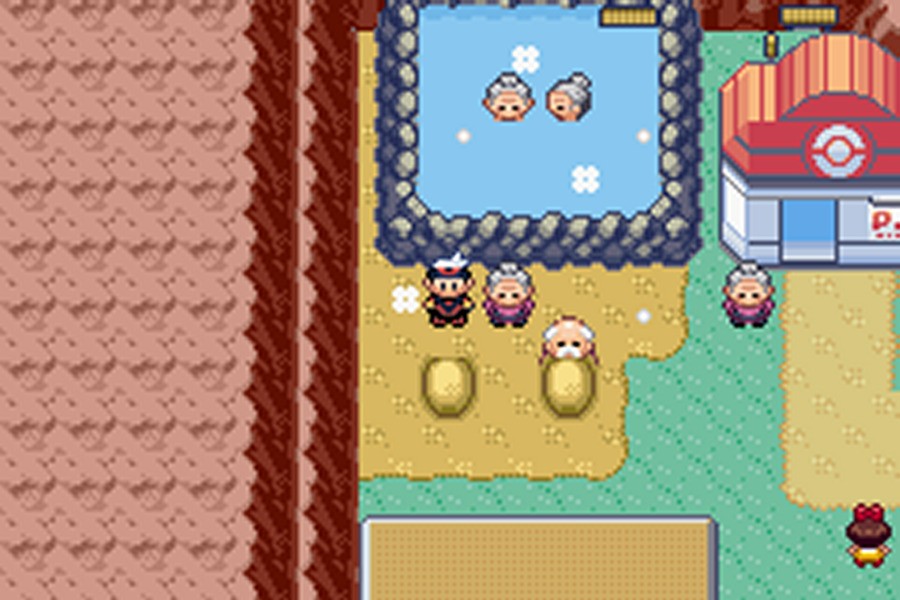
The main series
So, come November 21st 2002, exactly three years after the launch of Pokémon Gold & Silver and over a year after the Game Boy Advance hit the scene, Pokémon Ruby & Sapphire were first released in Japan and released later in 2003 in the US and Europe.
These games introduced a myriad of new Pokémon and a story that differed between the two versions, having you save the region of Hoenn from Team Magma or Team Aqua depending on the version, marking the first time that the versions differed in more than just available Pokémon; yet there is far more to these games than meets the eye.
The mechanical overhauls behind the scenes and even in front are the greatest generational leap we have had in Pokémon games. The Individual Value and Effort Value mechanics were radically altered, with possible IVs being doubles and there being caps on the amount of Effort Pokémon that a Pokémon can gain. It introduced the concept of Natures, which affected the Pokémon's stats and even gave each Pokémon one or two special abilities that can affect the course of battle such as Intimidate, which lowers the target's Attack, Static which paralyses a Pokémon on contact and so many more. It even introduced the concept of Double Battles, where you use 2 Pokémon at once, which has since become the official battling format of the competitive scene, used in the Video Game Championships each year. There's so much more that was added in these games, including various competitively focused items that didn't exist in Gold & Silver. I could go on for days about how this generation improved Pokémon
Despite these wonderful additions, these games have a bit of a mixed reputation. Due to all the new mechanics and changes in the IV & EVs, there were some issues. The Pokémon couldn't be transferred from Pokémon Gold, Silver and Crystal, so all the Pokémon you have trained since Red & Blue are forever locked in the game. To top it off, Ruby & Sapphire only had access to 202 of the now 386 Pokémon, locking players out of 184 of their old favourites from the generation for a while. This unfortunately turned a lot of people off, leaving a black mark on this generation.
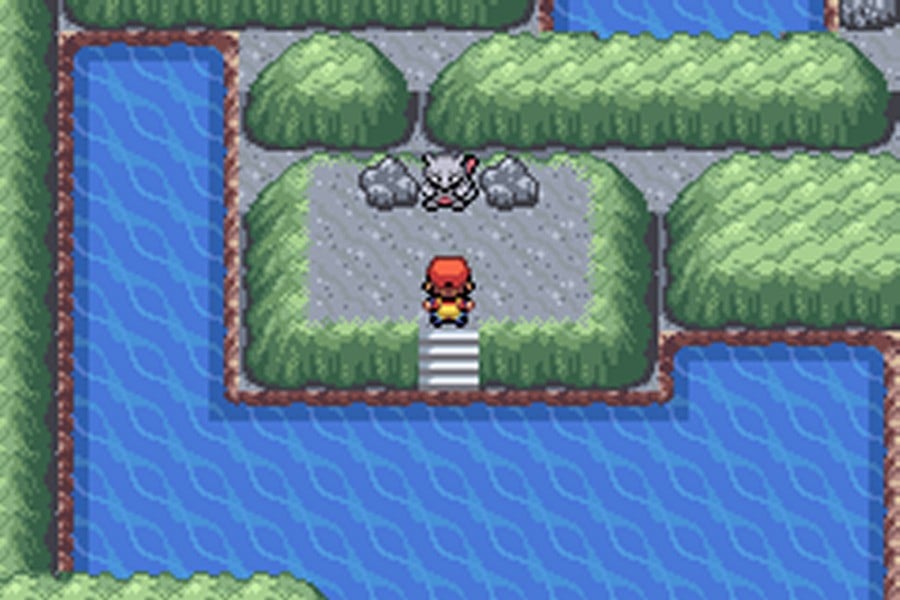
There's also something else this generation brought to the table in terms of main games: Remakes. In late August 2003 it was announced that remakes of the original Pokémon Red & Green were to be released. Since Pokémon from those games couldn't be transferred to Ruby & Sapphire, it was a logical fit and these games then were released in Japan in January 2004, just under 8 years after the originals. These games retold the story of Red in his travels through the Kanto region and used the mechanics introduced in Ruby & Sapphire to bring it up to the then modern times, but that's not all. After the main story, it opened up a new island range known as the Sevii Islands, with a few side quests and various other Pokémon, most of which were originally native to the Johto region.
Those games also introduced a replacement to the Game Boy Link Cable, the Wireless Adapter, which allowed for wireless communication between FireRed & LeafGreen games for battle, trade and mini-games. This device was packaged in with all copies of Pokémon FireRed & LeafGreen.
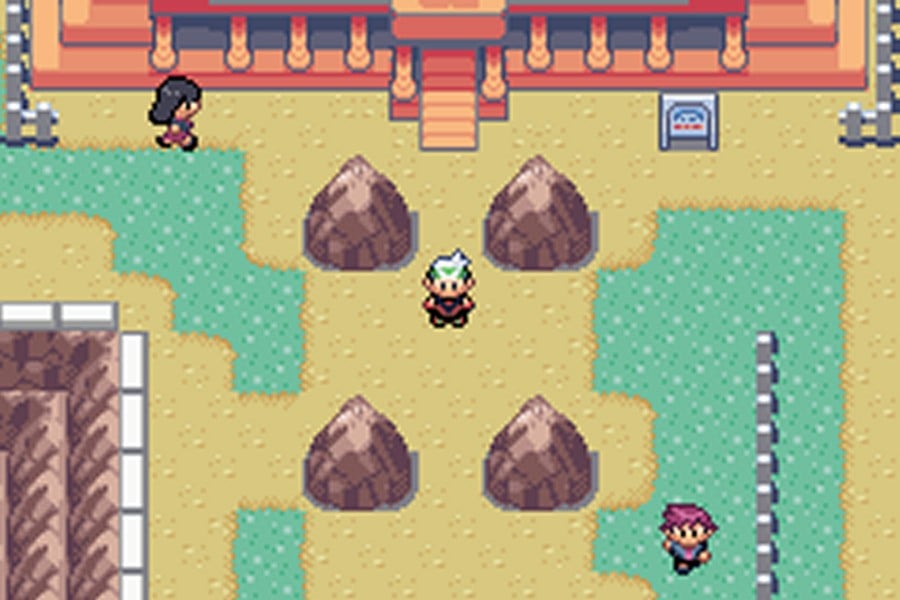
Next up was a return to Hoenn in the Rayquaza focused Pokémon Emerald, which came to Japan in September 2004 and the west in 2005. This game was a retelling of the Ruby & Sapphire games but had you face off against both Team Magma and Team Aqua and awaken the Pokémon Rayquaza to stop both teams from destroying the Hoenn region. One of the other complaints about Pokémon Ruby & Sapphire was the lack of a sufficient post-game, but Pokémon Emerald rectified that by introducing the now much beloved Battle Frontier, which housed seven different facilities, each with a different twist on battling such as the Battle Factory where you used randomly given Rental Pokémon, and the Battle Arena which judged you in three turns based on your Pokémon's performance.
All of these games also had e-Reader support in Japan and for Ruby & Sapphire only in the west. Ruby & Sapphire introduced various new trainers to battle in Mossdeep City, just scan them and you could face them. There were also various new berries you could get by scanning the cards. There were two sets of these cards released, with only the first making it to the US. FireRed & LeafGreen changed this up by having you scan various floors of the Trainer Tower located in Seven Island. These contained various trainers and Pokémon to defeat to get to the top for a prize. Pokémon Emerald had its own set of cards that worked in the Trainer Hill in Route 111. These cards worked much like the FireRed & LeafGreen cards.
The Pokémon
Now into the Pokémon of the generation, there were 135 Pokémon introduced, and unlike the previous generation there were very few related to old Pokémon, just Azurill and Wynaut. This gave this generation of Pokémon a completely different feel as you were mostly encountering brand new Pokémon.
The starter Pokémon were Treecko, Torchic and Mudkip, once again continuing the Grass, Fire and Water-type tradition of the starter Pokémon. They eventually evolved into Sceptile, Blaziken and Swampert. These differed from the previous generation in that Blaziken and Swampert had secondary types. Blaziken gained the Fighting-type and Swampert gained the Ground-type, giving them a wider range of capabilities.
There are eight Legendary Pokémon in this generation, the largest amount at that point. First off is the trio of Legendary Pokémon, Regirock, Regice and Registeel. These are legendary golem Pokémon and their inclusion connects with the game's seemingly unusual choice of using Braille for various puzzles in the game. Next is the duo Latias and Latios. These Pokémon are Dragon/Psychic-types and could be found roaming the region with one being exclusive to each game, but there was also a special event using e-Reader cards that allowed for you to download the Eon Ticket to give you the other one. Finally, there were the cover Legendary Pokémon. Kyogre is the signature Pokémon of Pokémon Sapphire and is a Water-type Pokémon with the ability to create perpetual rain. Groudon is the signature Pokémon of Pokémon Ruby and is a Ground-type Pokémon with the ability to create perpetual sunlight. Rayquaza is the signature Pokémon of Pokémon Emerald and is a Dragon/Flying-type Pokémon which can stop harsh weather from happening, acting as a calming third party to Groudon and Kyogre.
In this generation, it changed things up with Mythical Pokémon. Rather than just the one as seen in the past two generations, this generation introduced two of them and both were released to coincide with their respective movies.
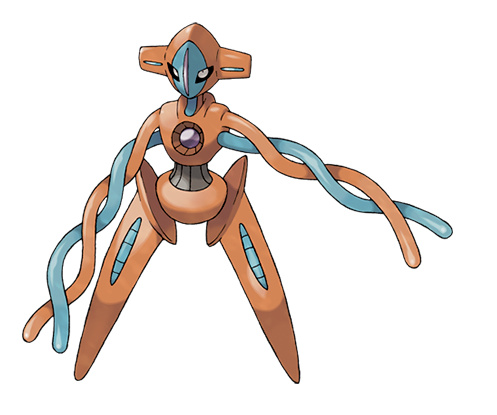
First is Jirachi, the Steel/Psychic-type Mythical Pokémon. It is what many would call a "cute" Mythical Pokémon as it has the base 100 stat in every stat. It's said to only awake once every 1,000 years. Secondly is Deoxys, the strange Psychic-type Pokémon which is said to come from space. Deoxys is the Mythical Pokémon that introduced the concept of changeable alternate forms. The form change made Deoxys have a completely different look, massively different stats and even a different learnset. In this generation, Deoxys' form was decided based on the game it was on: Ruby & Sapphire had its Normal Forme, FireRed had its Attack Forme, LeafGreen had its Defense Forme and Emerald had its Speed Forme. Nowadays, however, the form can be changed at will through various in-game areas.
But that's not all, there are lots of Pokémon to like that were introduced in this generation such as Salamence, the powerful Dragon/Flying type, Metagross, the Steel/Psychic-type that is used by the champion Steven Stone, Grumpig, and many more.
For a full list of Pokémon, you can find them here: http://www.serebii.net/games/generation3.shtml
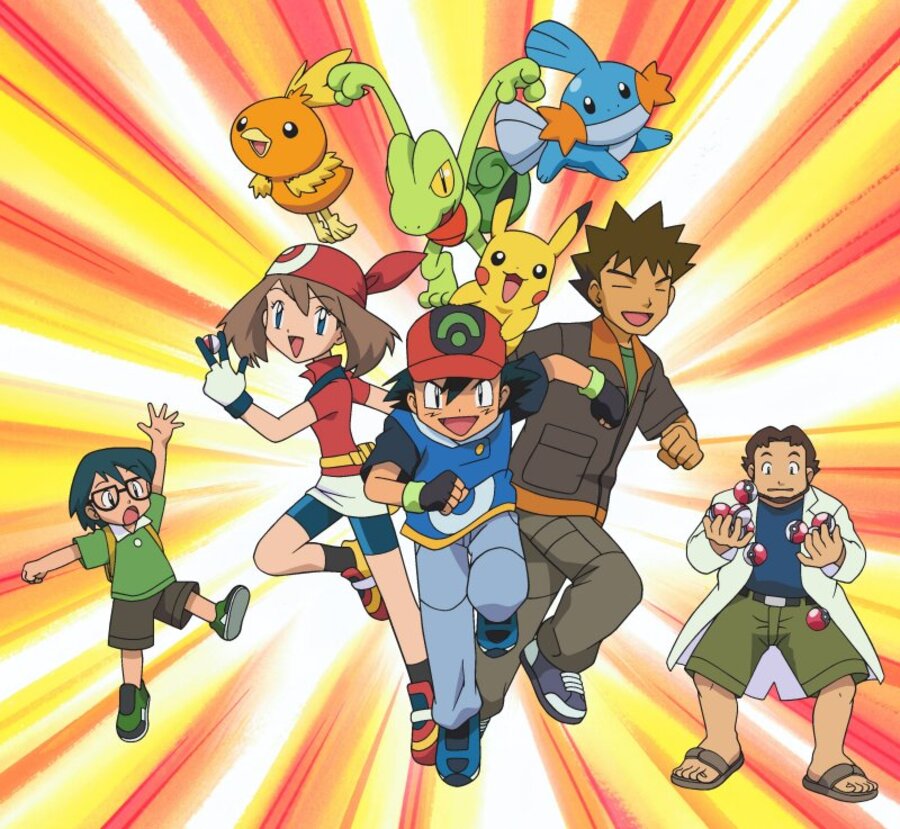
The anime
When November 2002 hit, the anime changed drastically. For the first time in the history of the show in Japan it changed its title to Pokémon: Advance Generation. After Ash learned of the Hoenn region from Harrison, he left Brock and Misty who were returning to the gyms in Kanto and he set off to Hoenn on his own, but a Team Rocket plot caused Pikachu to get sick as soon as he started to get to the region.
When there, he met up with a new trainer called May, who initially didn't really like Pokémon, and let Pikachu accidentally destroy her bike. She decided to join Ash on her journey, with her partnered with her Torchic. Her brother, Max, also joined them on their journey through the Hoenn Region, followed quickly by Brock, who returned to Ash's side after solving an issue with his family at the Pewter City Gym.
With Ash taking on the 8 gyms of Hoenn with Pokémon such as his Grovyle, Snorunt and Swellow and May facing off in the Pokémon Contests, they travelled through making friends and rivals such as Drew and even faced off against Team Magma and Team Aqua.
In the Hoenn League, Ash faced against one of his rivals, Tyson, who has a Meowth. In a tough battle, Tyson eventually claimed victory and took the Hoenn League. Following that, Ash, May, Max and Brock returned to the Kanto region where Ash decided to take on the Battle Frontier's Frontier Brains, eventually defeating them all, including Noland's Articuno and Brandon's Registeel, and got offered a place as being a Frontier Brain, which he declined.
During this generation, there was also a small series of specials. These specials aired in Japan during the series Pokémon Hoso, and in the west in a series called Pokémon Chronicles and featured episodes about various characters including Brock, Misty, Tracey, Team Rocket and Casey in their adventures after meeting Ash.
There were four movies during this saga of the anime. The first one focused on Jirachi and is called Jirachi - Wish Maker, where Ash & co. have to protect Jirachi after it wakes up for the first time in 1,000 years.
The second movie of the series, seventh overall, is called Destiny Deoxys and features Ash & co., entering LaRousse City where they find a Deoxys is causing mayhem, and Rayquaza steps in to stop it.
The third movie of the series, eighth overall, is called Lucario and the Mystery of Mew and features Ash & Co. encountering a Lucario who is trying to find out details about its old trainer.
The final movie of the series, ninth overall, is called Pokémon Ranger and the Temple of the Sea and ties in with the Pokémon Ranger spin-off title and has Ash & co. meeting a Pokémon Ranger who has been tasked with protecting the Mythical Pokémon, Manaphy.
The Spin-offs
The spin-off games in Generation 3 are where the spin-offs really started to kick off. Due to the delay in the launch of Diamond & Pearl from 2005 to 2006, making this the longest generation at that point, there were a lot of gaps to fill with spin-off games, some series of which still continue to this day.
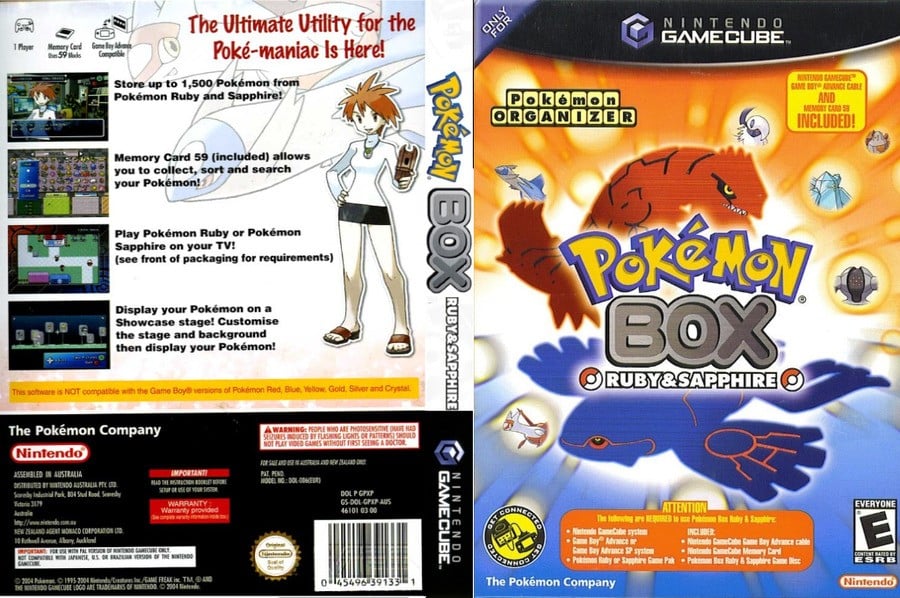
Nintendo GameCube
There were numerous games out on the Nintendo GameCube for Pokémon. The first of which is simply Pokémon Box: Ruby & Sapphire. This bit of software was the precursor to Pokémon Bank and allowed you to store Pokémon from your Game Boy Advance games onto the GameCube's memory card. You could store up to 1,500 and you got various gifts the more you gave such as a Surfing Pichu if you put in 1,499 Pokémon.
Next up is Pokémon Channel. This game was a spiritual successor to the Nintendo 64 title, Hey You! Pikachu! and had you befriend a Pikachu and watch various Pokémon related television shows with it, as well as explore the nearby area. This game had e-Reader support in Japan and in Europe it gave your Ruby & Sapphire games a Jirachi!
Next is Pokémon Colosseum. This game, while considered a spin-off, is closer to the main games than any other. In it, you play as a former Team Snagem Wes as he goes through the Orre region to stop Team Snagem and the overarching team Cipher from stealing people's Pokémon and turning them into Shadow Pokémon. These Pokémon could be caught by you by stealing them yourself and then sent to your Generation 3 games, usually with a special move.
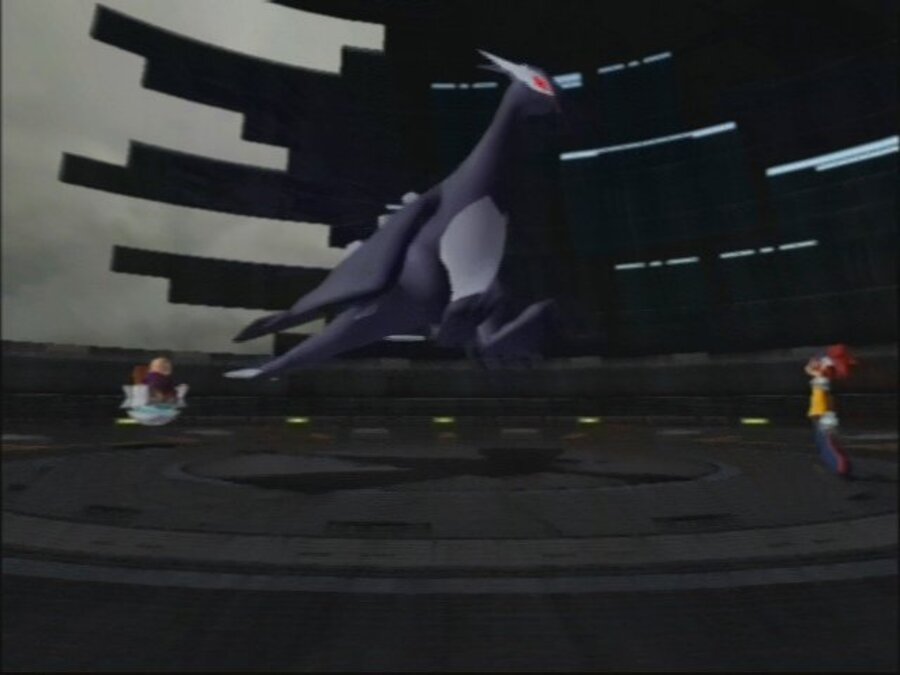
Following that was Pokémon XD: Gales of Darkness. This was a sequel to Pokémon Colosseum and had you play as another character called Michael as he travelled through Orre capturing Shadow Pokémon from trainers and purifying them. This game was also notable in that it included some Generation IV Pokémon in its actual gameplay rather than just references. In the PokéSpots, you would find Munchlax from time to time and in the Battle Bingo, you could get a sheet where you battled using Bonsly.
Game Boy Advance
There were very few Game Boy Advance spin-off titles within this generation, which is somewhat surprising at first glance, but considering the Nintendo DS's release in 2004, just two years after the generation began, it makes a lot of sense.
The first of the spin-offs is Pokémon Pinball: Ruby & Sapphire. This game was a sequel to the Game Boy Color Pokémon Pinball and utilised the Game Boy Advance's power to give you full colour boards as you played pinball to collect the 201 then available Pokémon in the Hoenn Pokédex, as well as the Johto starters. In Japan, it also had e-Reader support cards to make rare things in the game more common.
Game Boy Advance & Nintendo DS
The next game is unique in that it came in two versions. One was released on the Game Boy Advance and one was released on the Nintendo DS, and they could communicate with each other using passwords. This was the first ever Pokémon Mystery Dungeon game, Pokémon Mystery Dungeon Red Rescue Team (GBA) and Pokémon Mystery Dungeon Blue Rescue Team (DS), which combined the Roguelike gameplay mechanics of Chunsoft's Mystery Dungeon series with the Pokémon franchise. In the games you went through a variety of randomly generated dungeons collecting all Pokémon in your rescue team as you follow the story where you're a human who has turned into a Pokémon and have to solve a mystery about natural disasters which have begun happening all over the world. This game started the sub series which still continues to this day with the upcoming release of Pokémon Super Mystery Dungeon this month in the US and early next year in Europe.
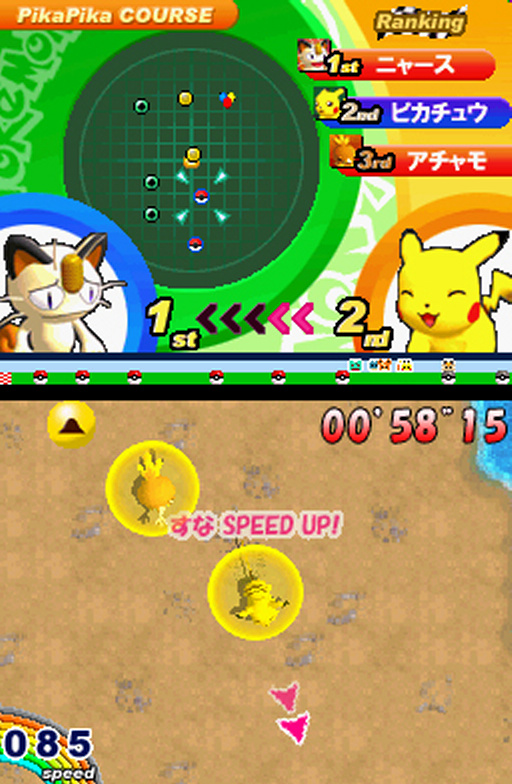
Nintendo DS
The first Pokémon game on the Nintendo DS is the title Pokémon Dash, which didn't receive much critical acclaim. It was a racing game where you controlled a Pikachu in races by continually swiping on the Nintendo DS's touch screen. This resulted in an iffy control system and an unfortunate lack of variety. However, it did have a special feature that brought in your team from the Game Boy Advance games if they were in the Nintendo DS and turned them into race courses for you to play on.
Next is Pokémon Trozei, also known as Pokémon Link!. This was a puzzle game that had you match together various Pokémon using the DS's touch screen to shift rows and columns to make the match ups. This had a variety of modes as well as a sotry where you played as Lucy Fleetfoot who was facing off against the Phobos Battalion. This game launched the puzzle series that continues to this day with the free-to-play title, Pokémon Shuffle.
Finally we have Pokémon Ranger. Another game that launched a sub series, this had you play as a Pokémon Ranger who uses wild Pokémon to help overcome various obstacles and protect the Fiore Region, and Pokémon within it, from the Go-Rock Squad. Temporary capture of these Pokémon is done by circling them on the DS's touch screen. It also connected with the main games by being able to send a special Manaphy over to the Generation 4 Pokémon games.
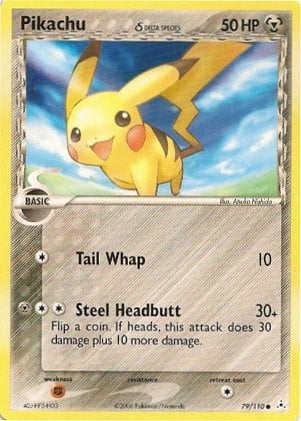
The TCG
The Trading Card Game continued on through Generation 3 with a variety of new cards. These cards began a new mechanic which is even still going today. These are the Pokémon EX cards which are basic cards that are really powerful but come at the cost of you giving the opponent 2 prize cards if the card is knocked out.
This mechanic continued through the entirety of the third generation cards, but various other mechanics did come in. Various Team Magma and Team Aqua cards were introduced. These cards had begun a concept where a Pokémon could have up to 2 types. They also included Delta Species which were a unique sets of cards where the Pokémon would have different types to normal such as a Steel-type Pikachu or an Electric-type Mewtwo.
The first three of the sets, EX Ruby & Sapphire, EX Sandstorm and EX Dragon continued to have e-Reader capabilities, but this just showed the Pokédex entry for that Pokémon.
Conclusion
As we approach September 2006 in our retrospective, the third generation of Pokémon comes to an end. This generation is one that is often looked at with a resounding "meh" by many in the fandom, but in actuality it is one of the most fundamentally important generations of Pokémon to have ever existed after the initial introduction of Pokémon. So many of the mechanics and features, and even spin-off series, which are considered standard to us today came from this generation.





Comments 57
the best pokemon generation : o)
Brace yourselves. Gen 3 haters are coming.
@Tulio517 I admit, I'm not that big a fan of Generation III, but the stuff it brought to the fold was amazing and so easy for people to forget that it came from this generation
I only played Red for the longest time. Because of middle school, I didn't follow gaming as much as my childhood, so I only played what friends had (and friends would never share portables for whatever reason). Then comes two years ago when I picked up Pokemon Y--first Pokemon game I decided to go through since Gen 1. I was utterly lost with so many new ideas.
The question I propose: should I go back to Gen 2 and work my way up to this latest gen? Or should I focus my time on other games, work, grad school, real people, life, etc.?
@Haiassai Just jump in with X&Y Perfect jumping in point!
@Serebii Yeah, you've got a point. I actually like it a lot. Sapphire was my first Pokémon game, I guess I'm a little bit biased.
On a side note, I've never played the Game Cube games, had forgotten about the Shadow Pokémon. Nice to see that Mewtwo in Pokkén being, maybe, a little reference.
Gen 1 or gtfo!
The generation that I remember most fondly. Gen 3 is honestly when the "new generation" of players came about, as Gen 2 was really a sequel generation for the original players.
Love this generation, and Sinnoh. The nostalgia is overwhelming.
"The Pokémon couldn't be transferred from Pokémon Gold, Silver and Crystal, so all the Pokémon you have trained since Red & Blue are forever locked in the game. To top it off, Ruby & Sapphire only had access to 202 of the now 386 Pokémon, locking players out of 184 of their old favourites from the generation for a while. This unfortunately turned a lot of people off, leaving a black mark on this generation."
As one of the biggest detractors for this generation, I have to point out one thing: I would have forgiven what couldn't have gone unmentioned, namely the reboot described in these six-or-so lines, if only Nintendo was more... generous with the Johto Pokémon included in the Kanto remakes. Which one were they? Let's see... as far as I can recall, there were Yanma, Sentret, Larvitar, Wooper, Marill (which barely counts due to it being accessible in Hoenn), Swinub, Delibird, Sneasel, Murkrow, Misdreavus, Hoppip, Qwilfish, Remoraid, Natu, Wobbuffet, Spinarak, Heracross, Ledyba, Phanpy, Skarmory (same thing as Marill), Unown and Mantine. This seems like a lot considering most of these have evolutions, until you remember that most of these Pokémon happen to be version-exclusive. What about the more memorable ones? Mareep? Event-exclusive, sorry. Lugia? You'd better have another console, a game, and a cable, otherwise you're out of luck. Do you want the Johto legendary beasts? Unless you have Colosseum, you only get one. It would have been nice to be able to access Johto in an inversion of Generation II's 16-badge quest, but I would have settled with Johto's fauna to be accessible - barring Celebi, which would have been excusable - in its entirety. THAT would have made FireRed and LeafGreen redeem the entire third generation in my eyes... which, of course, never happened.
Nevermind that players had no idea the previous Pokémon would come back at all when Ruby and Sapphire came out, as any mention of the mere existence of a National Pokédex was nowhere in sight at the time and Pikachu's number going from 25 to 156 implied this would be a complete reboot of the series, which thankfully turned out not to be. A far cry from how things currently are - in Generation VI, you can access all of the National Pokédex without needing a dozen of games, consoles and peripherals. Generation III, on the other hand, by relying on events (a justifiably reviled game mechanic still today, although accessing Event Pokémon with a simple visit at a GameStop store made all of this much more bearable) for Pokémon that were already rightfully caught and owned in Generation II, was Pokémon bureaucracy at its worst. And the franchise's bureaucracy, while it's much less obstructive nowadays, has always been one of the most valid points for the franchise's detractors.
Thank Arceus for Generation IV, with GTS, the Johto-esque Sinnoh and, obviously, HeartGold and SoulSilver.
I love gen 3!
While I think Gen II has better art, I think this gen really kept things going, this was one of the best gens for spins offs (if not thee best), they really knew what they were doing. I remember thinking that when this gen lasted so long that Pokemon may either come to an end or they'd stop making new pokemon and just do side games that would potentially get more extravagant. That didn't happen. Very influential gen, maybe the last for me that was this influential. I still played the DS games but that's when I slowly faded out to where I am now. Just kinda ok.
No one else has mentioned that typo? When talking about the change in EVs and IVs you refer to EVs as "effort Pokemon" at one point.
@Haiassai Focusing on life stuff would be definitely better than playing some old games that most of them are one or another way outdated. Unless you have well organised schedule and you control your time, and that's your hobby
But if you really want to experience the pokemon games I can give you my suggestion.
If you like retro you can go ahead and try the older games. But if I were you - a preson who wants catch up by playing previous pokemon games - I would go with HG/SS remakes (4th generation but WAAAY better than DPP) first (and only with Platinum if you ABSOLUTELY insist on playing DPP), then definitely BW - to see how the series evolved. I think you can skip B2W2 - they differ from they previous versions more than other enchanced or third versions (you know - Emerald, Platinum etc) but they are still similar, also felt short and I think the story wasn't that good as in BW. And without Nintendo Network you will miss some features!
You played gen 6 already but I think it will be good if you check out ORAS - for the consistency (you will get the glimpse of the 3rd gen). It acts similary to XY but has some nice features and exlusive pokemon.
So, to conclude - HG/SS - BW - ORAS. This will leave you with only 3 games to check with ability to transport your pokemon into the newest generation (unlike the pokemon cought in gen 1-2), while getting all the bonuses, items and events in the most recent 6th gen games (ORAS).
Edit: I just reminded myself that you can't transport pokemon from BW to 6th gen. You will need B2/W2 for that. If you want transfer your pokemon then go for B2W2 instead of BW.
This was the generation that got me into the Pokemon craze and I always thought had the best Pokémon design and world design (although Black and White changed my opinion on that a bit). The gen 3 may have its problems, but its one of my most nostalgic games because I never played anything like it before. It was a breathe of fresh air after being a Sega fan for so long and I was blown away by its music, art, and basically everything.
Ruby/Sapphire's story was incredibly stupid. The only evil team with a more stupid motivation than Team Magma/Aqua was Team Flare.
I still think IVs are incredibly stupid though. Riding around on a bicycle mass producing eggs hoping to win multiple dice rolls is not fun. There is no entertainment or skill here. Some argue IVs add "realism" but that's an incredibly stupid argument for a game about people who train monsters with supernatural abilities that they keep in their pocket in balls. Fact is IVs are a poor game mechanic. EVs and Natures already add diversity in stats, IVs just add a whole lot of luck based grinding.
Whenever you watch a Pokemon tournament it's clear many of the entrants, and usually the people who win, have hacked/created their Pokemon. Yeah, I believe you have a team of 6 shinys with perfect IVs, oh wait no I don't. Not that I really blame them because the IV mechanic is stupid.
But Generation 3 introduced my still favorite Pokemon so I can't complain.
I enjoyed ruby but too many HMs!!
"...with possible IVs being doubles and there being caps on the amount of Effort Pokémon that a Pokémon can gain."
Gen 3 was what got me into Pokemon!
My favorite generation. The one I grew up with and the one I hold dearest.
The most "meh" generation was also the one that I'd probably spent the most time with. I recall playing Sapphire version "via other means" until I had eventually bought a Nintendo DS closely after launch in mid 2005. I had later picked up Emerald (and I would have completed the single player mode at least 3-4 times) and received Pearl for my birthday from a friend when that launched.
I recall spending HOURS on Pearl (thanks to the GTS) and is perhaps my most played Pokémon game to date (likely owing to its extremely sluggish pace as opposed to its content), and it marked the first time that I had ever legitimately completed the Pokédex. I also completed the Pokédex for Platinum but I had felt too burned out to complete the dexes of the Generation V games; however, thanks to Pokémon Bank, I have a complete Pokédex in X and Alpha Sapphire, and I've recently bred and caught almost every single Pokémon from scratch in X version so that I could have a complete, fresh and nearly-complete Pokédex waiting for me in Pokémon Bank so that I'll never have to go back and capture all 700+ Pokémon again for future games.
While I'm certain that I have been on the receiving end of a lot of hacked Pokémon in Generation IV, I think I can safely say now that I have officially "caught them all" over Generations V and VI. The only Pokémon I'm missing now are Hoopa and Volcanion.
An evolution? More like a devolution! There are several mechanics in which 3rd gen regressed from 2nd gen, especially from Crystal: No day/night cycle (LOL), no innate wireless connection integration (unless you got the adapter with Leaf/Fire), no Pokémon sprite animations, a smaller overall world map, an overreliance on certain types (especially Water, although there is a story reason for it), lesser challenges, minimal move additions, the removal of many PokéGear features, a relative dearth of high level grinding spots, forgettable characters, no real Rival anymore, too many weak early creature choices (at least all of the starters were great), and no way to access most previous gen creatures in R/S/E without trading. There's more, but the list is already long enough...
Third gen is when the creature designs started to include... random "Things", for lack of a better term. I couldn't even tell what the hell a bunch of these things were! As Jontron and Egoraptor said in the Game Grumps Emerald play through, " Oh, it's a PUMBLOOM!" "...Jon? Did Ash ever encounter a Pumbloom on his adventure?" "Wait, I mean, I..." "NO!!!!!!!!!!!!"
That being said, I thought the story was quite topical. It's very reminiscent of the climate change issue that Earth is facing today, kicked up a notch. The world's destruction is nearly realized through humans trying to adapt and morph the land and sea to suit their desires- exactly the sort of thing which is slowly destroying our own planet now. The answer is a very pro-environmentalist message, which has become common for the Pokémon series.
The first and second generations included some environmentalist messages (e.g. the fossil fuel based Power Plant being abandoned), but they were in the background. Third gen is the one that put Pokémon's environmentalist messages front and center, amidst a world of people (ours) who seem hell bent on ignoring such issues; and for that, I applaud it.
Here is an ordered list of my favorite generations:
1. 3rd Gen: While this wasn't the first Pokemon game I played, it was the first one that I really got into and fully understood. Not only that, but I loved the tropical vibe to the game in the later areas and it is home to some of my favorite Pokemon, such as Flygon, as well as my favorite starter lineup.
2. 5th Gen (Black 2/White 2): The original Black and White were good games, however, the sequels were much better. The region was much more interesting, the story wasn't as serious, the Pokedex was much larger and included Pokemon from previous generations, and it had some of the best pacing in any recent Pokemon game. It is easily my favorite Pokemon games of the DS era, and one of my all-time.
3. 1st Gen: This is easily (and obviously) the most classic of all of the titles. Everything from the Pokemon design, the towns, the music, and the gym leaders just scream nostalgia. Hell, if it weren't for the unbalanced game mechanics with special attacks being overpowered (especially psychic types), I'd consider making this my all-time favorite. Seriously, no matter how much I try, I cannot stop myself from raising an Alakazam. It's just too tempting.
4. 2nd Gen: The second generation was such a great sequel to the originals. It introduced more of what made the original so great, while also adding new features such as a night and day system and another region to explore after the main game is over. While not the most revolutionary Pokemon title, it was one of the most addictive. Also, this generation probably has the best soundtrack.
5. 6th Gen: The first 3DS entries were truly great, adding three-dimensional visuals, new ways to train and interact with your Pokemon, an accessible online trading/battling component, and the biggest Pokedex yet. However, I do have some minor gripes that keep it from being further up on my list. The over-world visuals are meh, and for some reason not in 3D. The story, mainly the dialog, is really mediocre. However, my biggest issue is the lack of balance when it comes to training your Pokemon with the exp share. Using the item makes the game way too easy as you gain extra experience for all of your Pokemon. Turning it off not only makes the game way too difficult, as in "grind for endless hours just to beat the game" difficult. Overall, I still really enjoy these games and I'm currently finishing up my third play-through of this generation.
6. 5th Gen (Black/White): Black and White were really interesting games when they released. They were the first games to not use older Pokemon in the main game and they had a serious and dark plot structure to them. They were really fun to play through, however, I never had much of an urge to play through these games again. I'm not sure why exactly. It might be the overall different feel of the game or the weird story to it. At the end of the day, these games aren't bad at all, they're just a lot different from the rest of the series.
7: 4th Gen: It really pains me to put 4th gen at the bottom of this list. I love a lot of the Pokemon designs of this generation, the music is pretty catchy in it, it introduced some important game mechanics such as physical and special attacks not being restricted to typing, and it helped shape the meta for competitive play. However, the main-game has a lot wrong with it. A handful of the new Pokemon are not obtainable until post-game, and I'm talking about some really cool Pokemon such as Electivire and the Eeveelutions. Also, the game-play is unusually slow in Diamond and Pearl, making the game seem rather repetitive at times. The game also didn't look much different from the GameBoy versions, it just gave the character models and buildings depth to them. The battles looked near identical to the third gen, as well. However, I still do enjoy these games. Plus, they fixed a lot of these issues in Platinum.
Gen 3 rivals Gen 1 and 5 for being my favorite Generation. One of the few where I bother to complete the PokeDex.
@DarkKirby Yeah, when 7th gen releases, I hope IV's are abolished. They're completely pointless, all they do is either make the player waste their time, or resort to using illicit means to stay competitive. It just encourages cheating, and it's redundant. It needs to go.
I love generation 3 but that probably because of a lot of nostalgia (first Pokemon games with Firered and Emerald). Still the additions (like abilities) are so important that saying these games ruined Pokemon is silly. Critically I would say they are not the best at all (Hoenn did have to much water. I'm sorry but it is true) and not being able to transfer past Pokemon sucks. I still find more enjoyment though through Hoenn than Sinnoh and Kanto though.
Brandon's Regice, not Registeel.
I find Hoenn to be the most beautiful region and the remakes made it even prettier
Ruby and Sapphire was the first time I really got into Pokemon, as somehow I didn't care about it in Gen I and skipped Gen II entirely (always thought Slugma was a Gen III Pokemon lol), but the time sink was definitely Pearl.
My second Pokémon game was Pokémon Sapphire, I got it for Christmas 2007 after I got Diamond on my 10th birthday in November. It still to this day is one of my favorite games on the Advance and of all time. I got into Pokémon in Gen. IV the years when Pokémon was "uncool" like really uncool. Pokémon Ranger was another early gem on my DS. Not my favorite game, but another soft spot for me. God, I do love Gen III and Gen IV, definitely some of the most defining video games I have played.
Oh, yes! I actually find this one the richest!
First Pokemon game I ever played was Leafgreen and I realized how much I'd been missing! Soulsilver will always be the best game to me, but gen 3 was still very special.
I loved Gen 3.
It gave me Jirachi, natures, and abilities.
It was also the first gen to be patched, due to the first batch of R/S games had a bug that killed berry trees.
All you had to do was download an event Pokemon, Download Jirachi from the Bonus Disc, and/or connect to someone who had a patched version of the game.
Though I thought everyone else hated it for "ruining" Pokemon or that's what the gaming media reported and the forums posters said.
To this day people still are very vocal about their hatred for Gen 3.
Man, I love these articles, amazing job Joe.
3rd gen is one of my favorites. I was a bit disappointed when I found out that I'd never visit Johto in all its 32bit glory, but other than that, this game was amazing. It certainly helped that I'm a water type trainer
This Generation increased my interest in Pokemon, and especially a new kind of event: Pokemon Contests.
And my first game for GBA, with my money, was just Pokemon Sapphire, And still I try to win in the 5 contests categories, but the battery for the time is dry..., oh well; XD
I always find hilarious how Nintendo decided at the third generation to partition the utilities of the Pokemon Stadium games into three separate pieces of software:
-3D Battles went to Colloseum and XD, with an added dash of storyline.
-Minigames went to Pokemon Channel, with an added dash of Hey you Pikachu.
-Storage and playing on the TV went to Pokemon Box.
It was as if someone at Nintendo/The Pokemon Company suddenly saw Pokemon Stadium and though "Hey guys, we are giving players way too much content with this cartridges, I'm sure we could get two or three games out of this one"
@Yomerodes
Actually that's not what happened.
Market research and costumer feed back happened, leading to Pokemon Colosseum and XD happening as full RPGs with a Stadium style multiplayer mode.
The main complaints about Stadium 1&2 was the lack of a full RPG and the mini games.
Pokemon Box happened because avid Pokemon fans who did a lot of breeding complained about running out of room on their GBA carts.
It wasn't intended for the mass market. It was only sold in limited quantities.
Pokemon Channel game was aimed at kids and fans of the anime.
I think you're overstating the effects of the IV and EV overhaul. It's not that big of a mechanical change, especially for those who don't bother to train with them. While that in addition to the new Abilities, Natures, and Double Battles were some significant changes, I think they pale in comparison to the mechanics changes made in Generation 2, which introduced two new types and made a few other changes to the type chart (which in addition to many of the new added attacks greatly increased the balance between types in general), breeding, hold items, time based events, and fixed most of the glitches and broken strategies that were commonplace in the first generation.
Personally, Generation 3 is my least favorite of the bunch. While the new GBA graphics were great, and it had some nice new additions such as the Running Shoes, Abilities, and Double Battles, there were also plenty of problems.
Overall, I think these were the worst designed bunch of new Pokémon. While there are always some winners, there are also too many I just don't really like. While the 4th Generation did have too many evolutions of previous Pokémon and too many Legends, I still like most of them. The number Pokémon and attacks had also reached a degree that it became incredibly tiresome to complete the Pokédex pre-online trading, while the antiquated type-specific physical/special split became really annoying before the 4th Generation took care of those problems.
As for the new games, I do have to agree with IGN that there is too much water with all of the Surfing and Diving they make you do. The Pokémon contests were lame. They locked stuff away behind that flop of an e-reader system. Dividing the story between both versions was stupid. Finally, there was very little to do post-game. Thankfully, at least "Emerald" saw fit to correct the latter two issues.
I do have to give props to the spin-offs, though. "Colosseum" and "XD: Gale of Darkness" were both excellent games and the only full RPG console Pokémon games we've ever received. We also got an excellent portable pinball game and the beginnings of several quality long-running spin-off series. However, "Shuffle" is so much better than any of the "Trozei" games simply because most of the stages aren't time-based.
Gen 3 might still be my favourite. Getting all the Pokémon was a mess though (and I didn't achieve that until 5th generation). Aside from Ruby and Sapphire and Red and Green remakes, you also had to have Colosseum and that NGC-GBA-link cable. It was not easy to become a Pokémon master.
Colosseum and XD aren't that great but I still have fond memories of playing them. I wish I could play another Pokémon RPG on my TV again.
Gen 3 was great in it's own way. Better graphics, new stuff and changes to gameplay mechanics was very welcomed. Sure, it involved spending more time grinding and building up your Pokemon got "harder". But making a perfect setup should not be easy. It takes dedication to become Pokemon master.
Let me elaborate: the graphics had their best appearance here... quite soft-looking while 'stabilising'. The Natures and double battles added better dimensions to battling. Our Pokemon could relearn moves! The Contests added a pleasant yet immersive addition to the Pokemon world. The world was great, having what I found a good balance of water and land. Even the berry system was excellent! I even liked the e-Reader functionality!
Of course, later titles added great things: better moves of every type, the Fairy type, restoration of the Day-Night system, wireless interaction... even the Dream World/Online world! I just like this generation the most.
Ah, the last GOOD generation. Pokemon went to crap after this. Though, 4 did do some good things like restructuring moves and....that's it.
@KTT I eventually will get to all the games, but thanks for the recommendation
@serebii I still haven't beat Y. After playing locally with a friend, I realised how inefficient my playing approach was and felt too far behind to understand/fix it
@Tulio517 It made me laugh
@KTT I'm pretty sure it's possible to transfer Pokémon from BW directly to 6th gen. B2W2 is not needed.
@Calllack I'm glad someone did xD
@KTT All four Gen 5 titles, BW and B2W2, are allowed to directly transport to Gen 6.
Edit: Tulio beat me to it
@Yomerodes Yep, pretty much. They took out all of the utilities and added in the RPG aspect. There's no reason why they couldn't have left in the utilities and mini games, either. Isn't that what the GBA/GCN connector was supposed to be there for? A wasted opportunity, for sure.
@Xenocity No, they just wanted to make more money by dividing the products, rather than maximizing value.
Gen 3 I only remember Pokemon Mystery Dungeon: Red Rescue Team, because that was my 1st Pokemon game. Didn't actually play through the Hoenn region till ORAS. Gen 3 did add alot to the series though. FRLG is only other gen 3 game I played, but that was on PokeMMO lol. Wasn't till gen 4 when I played my 1st main series game and totally got absorbed into the franchise.
@Tulio517 @HADAA Indeed! I'm not sure why I thought it was B2/W2 only! Must had been that image of pokemon timeline fan theory I had seen few months ago which somehow confused me here
Thanks for correction!
@PlywoodStick
No, they actually took market research and consumer feedback to heart when making the GCN games.
You can honestly store GBA pokemon on Colosseum and XD, though you an only transfer one Pokemon at a time to the games.
You'd be surprised about the negative feedback the stadium games received from gamers back in the day due to it lacking a full RPG and having mini games.
@serebii :
"The Individual Value and Effort Value mechanics were radically altered, with possible IVs being doubles and there being caps on the amount of Effort Pokémon that a Pokémon can gain."
Typo ;p
This Gen was probably the height of my Pokémon obsession as a kid. I'm pretty sure I started with Gen 1 at a young age but I spent the most time with Gold — so long in fact that I didn't even realize new Pokémon games were out! I remember playing Pokémon Channel and being in awe at 'mon like Blaziken and Latios that I had never seen before. Eventually I got all three games, as well as FireRed, and played them a whole lot. I played a lot of spinoffs like Coliseum and Gale of Darkness too, good memories there — they don't seem to make spinoffs the way they used to. Also at the time I was really into the anime and movies, watching new episodes almost everyday, though once the D/P anime aired I lost interest in the show.
Anyways, lots of love for the 3rd Gen! This one is a favorite for nostalgia, though in those terms Gen 1 probably beats it and Gen 4 comes soon after 3. Lot of my favorite 'mon in there too, like Duskull, Sceptile, Deoxys and more. Omega Ruby is also one of my favorite Pokemon games now, I love what they did with those but I guess not everyone agrees.
It's great that a lot of people really like Gen 3 but for me it's when I lost interest. Gold/Silver did so much to push things forward— day/night system, two new types, entire second zone, pre-evolutions (pichu, Igglybuff, etc), refight trainers, the radio, legendaries that roam...I could go on.
Gen 3 did introduce some great gameplay tweaks (Natures, Abilities, etc) and 2v2 but it didn't feel as far a leap forward as Gold/Silver, at least to me. I still played through it and enjoyed it, of course, but Gen 3 doesn't hold a candle to its predecessors.
I'm gonna have a look and see how many total hours I put into Gen3 I'm betting I only played X&Y more.
Save for the more colourful GBA graphics, this generation wasn't as much of an improvement at first glance. Under the surface, though, things like natures and the expanded berry system really made the gameplay deeper and more interesting once you really looked into it. I wasn't too blown away by Ruby or Sapphire at first. The sizeable amount of new creatures was welcome, although I hated how many of the older Pokémon weren't available at first. Thankfully, later titles in this generation corrected this. The idea of Pokémon remakes was a clever way of keeping older Pokémon adventures available to new generations of players, while old fans got an easy way to get their hands on Pokémon from older titles. Once the Generation 1 remakes came along, suddenly there were two stories in two different worlds expanding each other greatly. In retrospect, it was a genious move by Game Freak. Sure, the GBA's high amount of remakes and ports got a little annoying after a few years, but FireRed and LeafGreen were amongst those that actually added something substantial to the original games. And that's exactly what a good remake should do. Then there was Emerald. The new Battle Frontier was pretty damn hardcore. Sure, the game was mostly the same thing as the other two Hoenn versions, but it also was the ultimate version and the biggest Pokémon experience ever at the time. What started as a little dissapointing for me, ultimately became one of my most played generations. So many memories!
The generation of ugly pokemon. lol
I just discovered these awesome retrospectives, and I just want to say GEN 3 IS THE BEST GEN!
Tap here to load 57 comments
Leave A Comment
Hold on there, you need to login to post a comment...